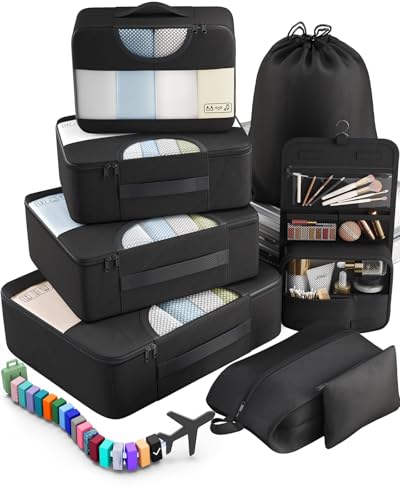In New Zealand, they use Type I power plugs and outlets. The voltage is 230V, and the frequency is 50Hz.
So, you’ll need a travel adapter in New Zealand. Their plugs and outlets are different from the Type A and B ones we use back in the States.
Quick Overview of the Plugs in New Zealand:
- Plug type in New Zealand: I
- Standard voltage: 230V
- Frequency: 50Hz
- Need a travel adapter? Yes, you do need a travel adapter
- Need a voltage converter? Might be needed depending on the device
- Recommended plug adapter: Vintar Universal Travel Adapter Kit
Our information is collected from local power authorities, verified with IEC international standards, and enriched by feedback from travelers worldwide.
The Only Travel Adapter You’ll Need in New Zealand
Imagine arriving in New Zealand and realizing your charger won’t fit. We don’t sell travel adapters, but we’ve researched and tested the best one—safe, reliable, and travel-friendly. Here’s our top pick:
Recommended Travel Plug Adapter
by 1,000+ travelers on Amazon
Forgetting your power adapter isn’t ideal, but it’s not the end of the trip. Chances are, you’ll still find one nearby. Still, packing one in advance means you’re ready to plug in the moment you land.
People visiting New Zealand often continue their journey to Australia, Fiji, and Niue. It’s smart to check if you’ll need a different plug.
Power Outlets in New Zealand
In New Zealand, they use Type I power plugs and outlets.
Type I

Type I outlets have two flat prongs in a V-shape with a grounding pin and accept both grounded and ungrounded Type I plugs; some ungrounded Type A plugs may fit with an adapter, but grounding will be lost.
Do You Need a Voltage Converter?
Since New Zealand has a different voltage than the U.S. (120V), you’ll probably need a voltage converter to keep your devices running smoothly.
Always verify the voltage rating on your device before packing it for a trip. If it reads “100-240V, 50/60 Hz”, it’s designed for international use and works with both 120V and 220-240V without needing a converter. Many phones, laptops, and rechargeable gadgets have this feature.

Which Travel Devices May Need a Converter?
Don’t want to guess which converter works? Here are the best-reviewed ones worth checking out.
| Device | Need Converter? | Notes |
|---|---|---|
| Phone | ❌ No (usually) | Most modern phone chargers are dual voltage (100–240V) |
| Laptop | ❌ No (usually) | Check the power brick label for 100–240V |
| Hairdryer | ✅ Yes (often) | High wattage; many models are not dual voltage |
| Electric toothbrush | ⚠️ Check voltage | Some models are 110V only |
| Camera / DSLR | ❌ No (usually) | Most chargers are dual voltage |
| Power bank | ❌ No | Charges via USB, adapter is enough |
| Electric shaver / trimmer | ⚠️ Check voltage | Older or cheaper models may not support 230V |
| Tablet / iPad | ❌ No | All models are dual voltage |
| Portable fan | ✅ Yes (sometimes) | Many models are not compatible with 230V |
| Game console | ⚠️ Check voltage | Newer consoles like PS5 and Xbox are often dual voltage — check to be sure |
| Bluetooth speaker | ❌ No (usually) | Charges via USB |
| E-reader (Kindle, etc.) | ❌ No | USB charging only, no converter needed |
Top Travel Essentials to Pack
Forget just the bare essentials—these extras make your trip more efficient, comfortable, and hassle-free.
Digital Luggage Scale
Packing Cubes
Power Bank
More About New Zealand
In the year ending December 2024, New Zealand welcomed about 3.3 million international visitors—up 12% from the previous year—and international tourism spending totaled approximately NZ$16.9 billion, nearly matching pre-pandemic levels. Tourism remains New Zealand’s second-largest export sector and is a growth engine for regional economies across both islands. A recent change in late 2024 saw the tourist entry levy increase to NZ$100, aimed at funding infrastructure and conservation efforts.
The country is compact yet diverse: Polynesian culture blends with Māori heritage; fjords and volcanoes rise within hours of beaches and forests; and unlike most destinations, English is universal and travel logistics are simple. Outdoor adventure—from glacier hikes, wine trails, and whale watching to geothermal valleys and alpine walks—feels authentically tied to local life. Conservation-minded tourism is also expanding, with many lodges and guided tours promoting sustainability in favorite spots like Fiordland, Rotorua, and the Southern Alps.
For American travelers, New Zealand checks off big scenery, friendly infrastructure, and cultural ease. Major cities like Auckland, Wellington, and Christchurch provide international flight access, while regional hubs like Queenstown and Napier bring outdoor epicness and wine country vibe. Whether you’re chasing glaciers, glowworm caves, beaches, or boutique vineyards, this country rewards curiosity and ease with memorable scope and warmth.
Top places to visit in New Zealand: Auckland, Wellington, Christchurch, Queenstown, Rotorua, Dunedin, Napier, and Nelson.




